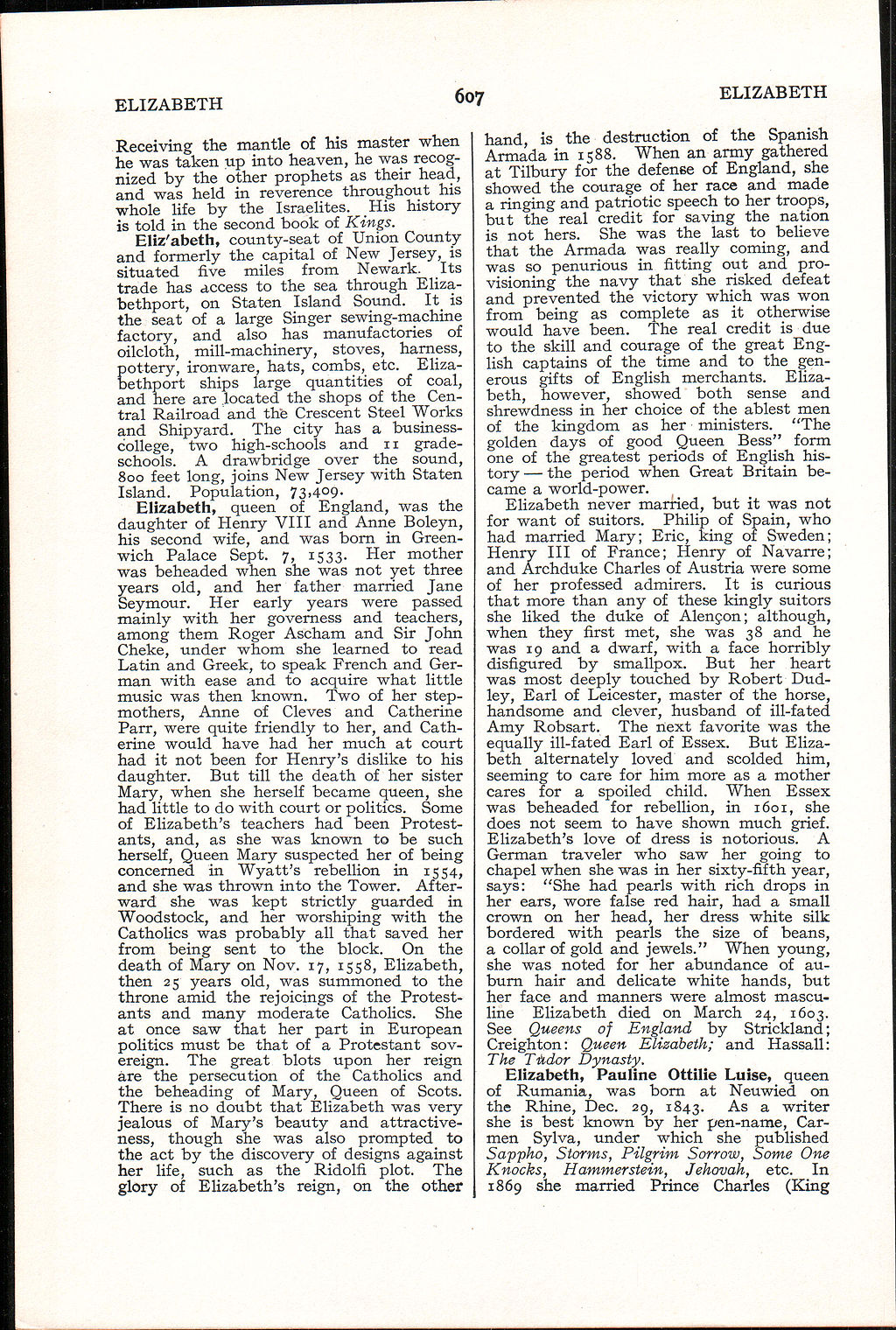ELIZABETH
607
ELIZABETH
Receiving the mantle of his master when he was taken up into heaven, he was recognized by the other prophets as their head, and was held in reverence throughout his whole life by the Israelites. His history is told in the second book of Kings.
Eliz'abeth, county-seat of Union County and formerly the capital of New Jersey, is situated five miles from Newark. Its trade has access to the sea through Eliza-bethport, on Staten Island Sound. It is the seat of a large Singer sewing-machine factory, and also has manufactories of oilcloth, mill-machinery, stoves, harness, pottery, ironware, hats, combs, etc. Eliza-bethport ships large quantities of coal, and here are located the shops of the Central Railroad and the Crescent Steel Works and Shipyard. The city has a business-college, two high-schools and n grade-schools. A drawbridge over the sound, 800 feet long, joins New Jersey with Staten Island. Population, 73,409.
Elizabeth, queen of England, was the daughter of Henry VIII and Anne Boleyn, his second wife, and was born in Greenwich Palace Sept. 7, 1533. Her mother was beheaded when she was not yet three years old, and her father married Jane Seymour. Her early years were passed mainly with her governess and teachers, among them Roger Ascham and Sir John Cheke, under whom she learned to read Latin and Greek, to speak French and German with ease and to acquire what little music was then known. Two of her stepmothers, Anne of Cleves and Catherine Parr, were quite friendly to her, and Catherine would have had her much at court had it not been for Henry's dislike to his daughter. But till the death of her sister Mary, when she herself became queen, she had little to do with court or politics. Some of Elizabeth's teachers had been Protestants, and, as she was known to be such herself, Queen Mary suspected her of being concerned in Wyatt's rebellion in 1554, and she was thrown into the Tower. Afterward she was kept strictly guarded in Woodstock, and her worshiping with the Catholics was probably all that saved her from being sent to the block. On the death of Mary on Nov. 17, 1558, Elizabeth, then 25 years old, was summoned to the throne amid the rejoicings of the Protestants and many moderate Catholics. She at once saw that her part in European politics must be that of a Protestant sovereign. The great blots upon her reign are the persecution of the Catholics and the beheading of Mary, Queen of Scots. There is no doubt that Elizabeth was very jealous of Mary's beauty and attractiveness, though she was also prompted to the act by the discovery of designs against her life, such as the Ridolfi plot. The glory of Elizabeth's reign, on the other
hand, is the destruction of the Spanish Armada in 1588. When an army gathered at Tilbury for the defense of England, she showed the courage of her race and made a ringing and patriotic speech to her troops, but the real credit for saving the nation is not hers. She was the last to believe that the Armada was really coming, and was so penurious in fitting out and provisioning the navy that she risked defeat and prevented the victory which was won from being as complete as it otherwise would have been. The real credit is due to the skill and courage of the great English captains of the time and to the generous gifts of English merchants. Elizabeth, however, showed both sense and shrewdness in her choice of the ablest men of the kingdom as her ministers. "The golden days of good Queen Bess" form one of the greatest periods of English history — the period when Great Britain became a world-power.
Elizabeth never married, but it was not for want of suitors. Philip of Spain, who had married Mary; Eric, king of Sweden; Henry III of France; Henry of Navarre; and Archduke Charles of Austria were some of her professed admirers. It is curious that more than any of these kingly suitors she liked the duke of Alencon; although, when they first met, she was 38 and he was 19 and a dwarf, with a face horribly disfigured by smallpox. But her heart was most deeply touched by Robert Dudley, Earl of Leicester, master of the horse, handsome and clever, husband of ill-fated Amy Robsart. The next favorite was the equally ill-fated Earl of Essex. But Elizabeth alternately loved and scolded him, seeming to care for him more as a mother cares for a spoiled child. When Essex was beheaded for rebellion, in 1601, she does not seem to have shown much grief. Elizabeth's love of dress is notorious. A German traveler who saw her going to chapel when she was in her sixty-fifth year, says: "She had pearls with rich drops in her ears, wore false red hair, had a small crown on her head, her dress white silk bordered with pearls the size of beans, a collar of gold and jewels." When young, she was noted for her abundance of auburn hair and delicate white hands, but her face and manners were almost masculine Elizabeth died on March 24, 1603. See Queens of England by Strickland; Creighton: Queen Elizabeth; and Hassall: The Tudor Dynasty,
Elizabeth, Pauline Ottilie Luise, queen of Rumania, was born at Neuwied on the Rhine, Dec. 29, 1843. As a writer she is best known by her pen-name, Carmen Sylva, under which she published Sappho, Storms, Pilgrim Sorrow, Some One Knocks, Hammerstein, Jehovah, etc. In 1869 sne married Prince Charles (King
